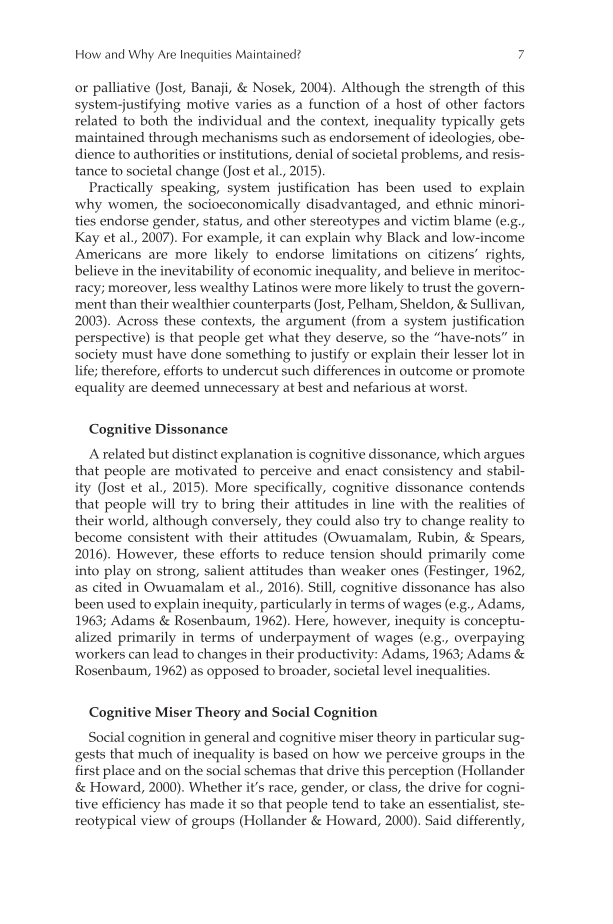How and Why Are Inequities Maintained? 7 or palliative (Jost, Banaji, & Nosek, 2004). Although the strength of this system-justifying motive varies as a function of a host of other factors related to both the individual and the context, inequality typically gets maintained through mechanisms such as endorsement of ideologies, obe- dience to authorities or institutions, denial of societal problems, and resis- tance to societal change (Jost et al., 2015). Practically speaking, system justification has been used to explain why women, the socioeconomically disadvantaged, and ethnic minori- ties endorse gender, status, and other stereotypes and victim blame (e.g., Kay et al., 2007). For example, it can explain why Black and low-income Americans are more likely to endorse limitations on citizens’ rights, believe in the inevitability of economic inequality, and believe in meritoc- racy moreover, less wealthy Latinos were more likely to trust the govern- ment than their wealthier counterparts (Jost, Pelham, Sheldon, & Sullivan, 2003). Across these contexts, the argument (from a system justification perspective) is that people get what they deserve, so the “have-nots” in society must have done something to justify or explain their lesser lot in life therefore, efforts to undercut such differences in outcome or promote equality are deemed unnecessary at best and nefarious at worst. Cognitive Dissonance A related but distinct explanation is cognitive dissonance, which argues that people are motivated to perceive and enact consistency and stabil- ity (Jost et al., 2015). More specifically, cognitive dissonance contends that people will try to bring their attitudes in line with the realities of their world, although conversely, they could also try to change reality to become consistent with their attitudes (Owuamalam, Rubin, & Spears, 2016). However, these efforts to reduce tension should primarily come into play on strong, salient attitudes than weaker ones (Festinger, 1962, as cited in Owuamalam et al., 2016). Still, cognitive dissonance has also been used to explain inequity, particularly in terms of wages (e.g., Adams, 1963 Adams & Rosenbaum, 1962). Here, however, inequity is conceptu- alized primarily in terms of underpayment of wages (e.g., overpaying workers can lead to changes in their productivity: Adams, 1963 Adams & Rosenbaum, 1962) as opposed to broader, societal level inequalities. Cognitive Miser Theory and Social Cognition Social cognition in general and cognitive miser theory in particular sug- gests that much of inequality is based on how we perceive groups in the first place and on the social schemas that drive this perception (Hollander & Howard, 2000). Whether it’s race, gender, or class, the drive for cogni- tive efficiency has made it so that people tend to take an essentialist, ste- reotypical view of groups (Hollander & Howard, 2000). Said differently,
Document Details My Account Print multiple pages
Print
You have printed 0 times in the last 24 hours.
Your print count will reset on at .
You may print 0 more time(s) before then.
You may print a maximum of 0 pages at a time.




































































































































































































































































